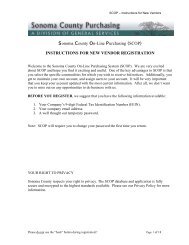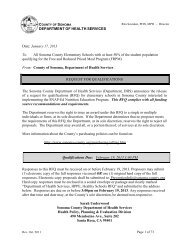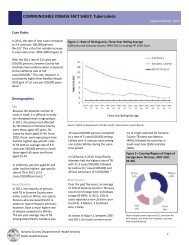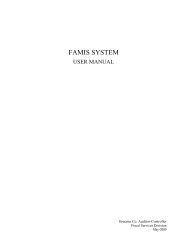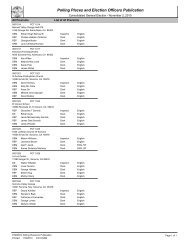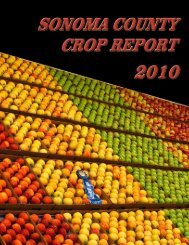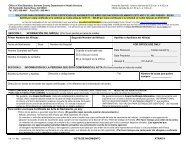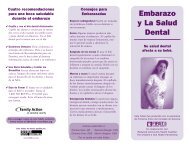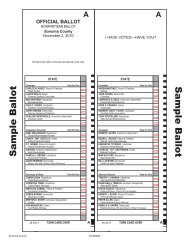Sonoma County General Plan 2020 Noise Element as amended 10 ...
Sonoma County General Plan 2020 Noise Element as amended 10 ...
Sonoma County General Plan 2020 Noise Element as amended 10 ...
You also want an ePaper? Increase the reach of your titles
YUMPU automatically turns print PDFs into web optimized ePapers that Google loves.
<strong>Sonoma</strong> <strong>County</strong> <strong>General</strong> <strong>Plan</strong> <strong>2020</strong><br />
NOISE ELEMENT<br />
<strong>Sonoma</strong> <strong>County</strong> Permit and Resource Management Department<br />
2500 Ventura Avenue<br />
Santa Rosa, California 95403<br />
Adopted by Resolution No. 08-0808<br />
of the <strong>Sonoma</strong> <strong>County</strong> Board of Supervisors<br />
September 23, 2008<br />
Amended by Resolution No. 12-0512<br />
October 23, 2012
<strong>Noise</strong> <strong>Element</strong><br />
TABLE OF CONTENTS<br />
1. INTRODUCTION ............................................................................... 3<br />
1.1 PURPOSE ................................................................................................................................................. 3<br />
1.2 RELATIONSHIP TO OTHER ELEMENTS ..................................................................................... 3<br />
2. EXISTING AND FUTURE NOISE ENVIRONMENT .................................. 5<br />
2.1 METHODS OF NOISE ANALYSIS ................................................................................................... 5<br />
2.2 NOISE SOURCES IN SONOMA COUNTY ................................................................................... 8<br />
3. NOISE ISSUES, POLICIES AND STANDARDS ..................................... 14<br />
3.1 LAND USE COMPATIBILITY AND PROJECT REVIEW ........................................................ 14<br />
3.2 MANAGEMENT OF TRANSPORTATION RELATED NOISE ................................................ 18<br />
4. NOISE ELEMENT IMPLEMENTATION PROGRAM ................................ 20<br />
FIGURES<br />
Figure NE-1: ...... Location of Significant <strong>Noise</strong> Sources and <strong>Noise</strong> Monitoring<br />
Sites ........................................................................................ After Text<br />
TABLES<br />
Table NE- 1 Examples of A-Weighted Sound Levels and Relative<br />
Loudness ............................................................................................... 6<br />
Table NE- 2 Maximum Allowable Exterior <strong>Noise</strong> Exposures for<br />
Non-transportation <strong>Noise</strong> Sources ......................................................... 15<br />
Footnote: *Mitigation Policy<br />
Page NO-2
<strong>Noise</strong> <strong>Element</strong><br />
NOISE ELEMENT<br />
1.1 PURPOSE<br />
1. INTRODUCTION<br />
The <strong>Noise</strong> <strong>Element</strong> of GP <strong>2020</strong> is a planning document that provides a policy framework for<br />
addressing potential noise impacts encountered in the planning process. The <strong>Noise</strong> <strong>Element</strong> is<br />
intended to provide ways to reduce existing and future noise conflicts. It includes policies and<br />
me<strong>as</strong>ures to achieve noise compatibility between land uses.<br />
In accordance with State law and guidelines, the <strong>Noise</strong> <strong>Element</strong> identifies noise sources and<br />
noise sensitive land uses. It quantifies noise levels using noise exposure contours for current<br />
and projected conditions within the county. Existing noise Levels are me<strong>as</strong>ured <strong>as</strong> Community<br />
<strong>Noise</strong> Equivalent Level (CNEL) or the Day-Night Average Level (Ldn), which are me<strong>as</strong>urements<br />
of total noise exposure at a given location for an average day. This noise exposure information<br />
serves <strong>as</strong> a b<strong>as</strong>is for achieving land use compatibility within each community and provides<br />
b<strong>as</strong>eline levels and noise source identification for use in a noise control ordinance or during the<br />
review of proposed development projects.<br />
1.2 RELATIONSHIP TO OTHER ELEMENTS<br />
The <strong>Noise</strong> <strong>Element</strong> is related to the Land Use, Housing, Circulation and Transit, Open Space and<br />
Resource Conservation, and Air Transportation <strong>Element</strong>s of GP <strong>2020</strong>. Recognition of the<br />
interrelationship of noise and these elements is necessary to prepare an integrated general<br />
plan. The relationship between these elements is briefly discussed below:<br />
Land Use<br />
An objective of the <strong>Noise</strong> <strong>Element</strong> is to provide noise exposure information for use in the Land<br />
Use <strong>Element</strong>. When integrated with the <strong>Noise</strong> <strong>Element</strong>, the Land Use <strong>Element</strong> will show<br />
acceptable land uses in relation to existing and projected noise levels.<br />
Housing<br />
The Housing <strong>Element</strong> considers the provision of adequate sites for new housing and standards<br />
for housing stock. Since residential land uses are noise sensitive, the noise exposure<br />
Footnote: *Mitigation Policy<br />
Page NO-3
information of the <strong>Noise</strong> <strong>Element</strong> must be considered when planning the locations of new<br />
housing.<br />
<strong>Noise</strong> <strong>Element</strong><br />
Circulation and Transit<br />
The circulation system, which is a major source of noise, must be correlated with the Land Use<br />
<strong>Element</strong>. This is especially true for roadways which carry significant numbers of trucks. <strong>Noise</strong><br />
Exposure will thus be a decisive factor in the location and design of new transportation facilities,<br />
and in the mitigation of noise produced by existing facilities upon existing and planned land<br />
uses.<br />
Open Space and Resource Conservation<br />
Excessive noise adversely affects the enjoyment of recreational pursuits in designated open<br />
space, particularly in are<strong>as</strong> where quiet is a valued part of the recreational experience. Thus,<br />
noise exposure should be considered in planning for this kind of open space use. Conversely,<br />
open space can be used to buffer noise sensitive uses from noise sources by providing setbacks<br />
and visual screening.<br />
Air Transportation<br />
The Air Transportation <strong>Element</strong> (ATE) sets forth operating policies for the <strong>County</strong> owned<br />
Charles M. Schulz Municipal Airport, and establishes the <strong>Sonoma</strong> <strong>County</strong> Comprehensive Airport<br />
Land Use <strong>Plan</strong> (CALUP) <strong>as</strong> the primary policy document addressing land use compatibility and<br />
noise issues arising from the six public use airports in the <strong>County</strong>. The ATE and CALUP contain<br />
noise contours and noise standards applicable to proposed development in the vicinity of the<br />
airports.<br />
1.3 SCOPE AND ORGANIZATION<br />
The content of a <strong>Noise</strong> <strong>Element</strong> and the methods used in its preparation are requirements of<br />
California Government Code Section 65302 and the California <strong>General</strong> <strong>Plan</strong> Guidelines. The<br />
Guidelines require that major noise sources and are<strong>as</strong> containing noise sensitive land uses be<br />
identified and quantified by preparing generalized noise exposure contours for current and<br />
projected conditions.<br />
The <strong>Noise</strong> <strong>Element</strong> is organized into four major sections: 1) an introduction, 2) an overview of<br />
the existing and future noise environment, 3) noise issues, policies and standards, and 4) an<br />
implementation program.<br />
According to the Government Code requirements, noise exposure information should be<br />
included in a <strong>Noise</strong> <strong>Element</strong> for the following major noise sources:<br />
Footnote: *Mitigation Policy<br />
Page NO-4
<strong>Noise</strong> <strong>Element</strong><br />
• Highway and freeways<br />
• Primary arterial and major local streets<br />
• Railroad operations<br />
• Aircraft and airport operations<br />
• Local industrial facilities<br />
• Recreational, entertainment and special events<br />
• Other stationary sources<br />
<strong>Noise</strong> sensitive uses identified by the Government Code include the following:<br />
• Residences<br />
• Schools<br />
• Hospitals, nursing homes<br />
• Churches, libraries<br />
• Long term medical or mental care facilities<br />
• Office building interiors<br />
• Other uses deemed noise sensitive by the local jurisdiction<br />
A <strong>Noise</strong> <strong>Element</strong> Technical Reference Document, on file in PRMD, describes in greater detail,<br />
the effects of noise on people and techniques for noise control and analysis. It also includes<br />
data from the community noise survey and highway noise evaluation. It is a reference for use<br />
by <strong>Sonoma</strong> <strong>County</strong> during the review of documents or proposals which refer to the<br />
me<strong>as</strong>urement and affects of noise.<br />
2. EXISTING AND FUTURE NOISE ENVIRONMENT<br />
2.1 METHODS OF NOISE ANALYSIS<br />
<strong>Noise</strong> and Its Effects on People<br />
<strong>Noise</strong> is often described <strong>as</strong> unwanted<br />
sound, and thus is a subjective reaction to<br />
the physical phenomenon of sound. Sound<br />
is variations in air pressure that the ear can<br />
detect. <strong>Noise</strong> h<strong>as</strong> often been cited <strong>as</strong> a<br />
health problem because it inhibits general<br />
well being and contributes to undue stress<br />
and annoyance. <strong>Noise</strong> interferes with<br />
sleep, speech, recreation, and t<strong>as</strong>ks<br />
demanding concentration or coordination.<br />
The result is an incre<strong>as</strong>e in public<br />
annoyance with the noise source and a<br />
decre<strong>as</strong>e in environmental quality. The<br />
various noise exposure limits of different<br />
Footnote: *Mitigation Policy<br />
Page NO-5
<strong>Noise</strong> <strong>Element</strong><br />
State and Federal agencies range from 75 to 90 dB’s to protect hearing over the long term.<br />
However, the EPA recommends a level of 55 dB L dn to protect against non-auditory health<br />
effects such <strong>as</strong> hypertension, cardiov<strong>as</strong>cular dise<strong>as</strong>e and nervous disorders.<br />
In very quiet environments, virtually any change in local activities will cause an incre<strong>as</strong>e in noise<br />
levels and a loss of "peace and quiet". Such incre<strong>as</strong>es may be considered significant by<br />
residents in these are<strong>as</strong>, even if the me<strong>as</strong>ured incre<strong>as</strong>e is small<br />
Me<strong>as</strong>uring Sound Levels<br />
Decibel (dB). The most common unit of sound me<strong>as</strong>urement is the decibel, and is<br />
abbreviated <strong>as</strong> dB. The threshold of hearing is considered to be 0 dB, and the range of sounds<br />
in normal human experience is 0 to 140 dB.<br />
Weighting Scales (dBA). Sound waves travel at different frequencies. Because the human<br />
ear is not <strong>as</strong> sensitive at some frequencies, different sound weighting scales have been<br />
developed. The "A" weighting scale is the most commonly used for environmental noise<br />
<strong>as</strong>sessment, <strong>as</strong> it correlates well with human response to noise sources such <strong>as</strong> aircraft and<br />
traffic. To me<strong>as</strong>ure low frequency sound levels, such <strong>as</strong> bl<strong>as</strong>ting, the use of a “C” weighting<br />
scale may be more appropriate.<br />
Typical Sound Levels. When an A weighting filter is used to me<strong>as</strong>ure sound pressure levels,<br />
the results may be expressed <strong>as</strong> dBA or dB(A) for clarity. Table NE-1 shows typical sound<br />
levels and relative loudness for various types of noise environments.<br />
Table NE- 1 Examples of A-Weighted Sound Levels and Relative Loudness<br />
Sound<br />
Sound<br />
Level<br />
(dBA)<br />
Relative<br />
Loudness<br />
(approximate)<br />
Relative<br />
Sound<br />
Energy<br />
Jet aircraft, <strong>10</strong>0 feet 130 128 <strong>10</strong>000000<br />
Rock music with amplifier 120 64 <strong>10</strong>00000<br />
Thunder, snowmobile (operator) 1<strong>10</strong> 32 <strong>10</strong>0000<br />
Boiler shop, power mower <strong>10</strong>0 16 <strong>10</strong>000<br />
Orchestral crescendo at 25 feet, noisy<br />
90 8 <strong>10</strong>00<br />
k h<br />
Busy street 80 4 <strong>10</strong>0<br />
Interior of department store 70 2 <strong>10</strong><br />
Ordinary conversation, 3 feet away 60 1 1<br />
Footnote: *Mitigation Policy<br />
Page NO-6
<strong>Noise</strong> <strong>Element</strong><br />
Quiet automobile at low speed 50 1/2 0.1<br />
Average office 40 1/4 0.01<br />
City residence 30 1/8 0.001<br />
Quiet country residence 20 1/16 0.0001<br />
Rustle of leaves <strong>10</strong> 1/32 0.00001<br />
Threshold of hearing 0 1/64 0<br />
Source: (1)<br />
U.S. Department of Housing and Urban Development, “Aircraft <strong>Noise</strong> Impact -- <strong>Plan</strong>ning<br />
G id li f L l A i ” 1972<br />
Ambient <strong>Noise</strong> Levels. The ambient (or background or pre-project) noise level is defined <strong>as</strong><br />
the noise from all sources near and far, and usually refers to the noise level that is present<br />
before a noise source being studied is introduced.<br />
Sound Average Level Over Time (L eq , CNEL and LDN). L eq represents the average or<br />
equivalent me<strong>as</strong>ured energy from all noise events observed or me<strong>as</strong>ured during a specified<br />
interval of time. <strong>Noise</strong> exposure contours or noise contours are lines drawn about a noise<br />
source representing constant levels of noise energy or exposure. The CNEL and LDN<br />
descriptors are variations of the L eq that represent the average noise level for a 24 hour day<br />
after including a <strong>10</strong> dB penalty for noise levels occurring at night between the hours of <strong>10</strong>:00<br />
p.m. and 7:00 a.m. The CNEL descriptor additionally includes a penalty of 5 dB for noise levels<br />
occurring during the evening hours of 7:00 p.m. and <strong>10</strong>:00 p.m. The CNEL descriptor is<br />
required when preparing noise exposure maps for airports within the State of California. The<br />
L dn descriptor h<strong>as</strong> been used in this <strong>Noise</strong> <strong>Element</strong> to quantify noise from transportation noise<br />
sources. The CNEL and L dn descriptors are generally considered to be equivalent to each other<br />
for most community noise environments within ±1.0 dB.<br />
Sound Level Exceeded During Specified Percentage of Time. (L <strong>10</strong> , L 50 , L 90 , L MIN ,<br />
L MAX ,etc.). If a noise source operates only a few hours a day, averaging the noise over 24<br />
hours may under estimate its nuisance potential (example: amplified music, bl<strong>as</strong>ting, drag<br />
races). Because many industrial, or stationary, noise sources operate sporadically, the hourly<br />
L 50 and L max are more useful for predicting noise conflicts from such sources than is the L dn .<br />
The L 50 represents the median noise level or noise level exceeded 50% of the time. The<br />
maximum (L max ) noise level is the highest level observed. To describe less extreme variations in<br />
sound levels, other statistical descriptors may be used, such <strong>as</strong> the L <strong>10</strong> and L 50 and L 90 .<br />
Community <strong>Noise</strong> Survey<br />
A community noise survey w<strong>as</strong> conducted to document noise exposure in representative are<strong>as</strong><br />
of the <strong>County</strong> containing noise sensitive land uses. The following noise sensitive land uses have<br />
been identified for the purpose of this survey.<br />
Footnote: *Mitigation Policy<br />
Page NO-7
<strong>Noise</strong> <strong>Element</strong><br />
• All residential uses<br />
• Schools<br />
• Long-term care medical facilities, such <strong>as</strong> hospitals, nursing homes, etc.<br />
• Places of public worship<br />
• Libraries<br />
<strong>Noise</strong> monitoring sites were selected to be representative of typical conditions where such uses<br />
are located. The community noise me<strong>as</strong>urements were conducted in July 2002, and indicate<br />
that typical cumulative noise levels in noise-sensitive are<strong>as</strong> range from 45 to 55 dB L dn . The<br />
community noise survey results indicated that median (L 50 ) noise level values in most locations<br />
are relatively low, especially at night. The relatively low noise levels are typical of small<br />
communities and rural are<strong>as</strong>. In more developed are<strong>as</strong>, incre<strong>as</strong>ed local traffic will result in<br />
higher noise levels, in the range of 55 to 65 dB L dn . <strong>Noise</strong> level data collected during the<br />
community noise survey are summarized in the Technical Reference Document.<br />
2.2 NOISE SOURCES IN SONOMA COUNTY<br />
Overview of Sources<br />
The noise exposure information developed during the preparation of the <strong>Noise</strong> <strong>Element</strong> does<br />
not include all conceivable sources of industrial or commercial noise within <strong>Sonoma</strong> <strong>County</strong>, but<br />
rather focuses on the existing sources of noise that have been identified by the <strong>County</strong> <strong>as</strong> being<br />
potentially significant. As the policies of this <strong>Noise</strong> <strong>Element</strong> are applied in the future, it is likely<br />
that other potentially significant sources will be identified.<br />
The following potentially significant sources of community noise are addressed in this <strong>Noise</strong><br />
<strong>Element</strong> and are shown on Figure NE-1:<br />
• Traffic on State highways and major <strong>County</strong> roads<br />
• Aircraft operations at public use airports<br />
• Industrial and heavy commercial activities<br />
• Northwest Pacific Railroad (NWPRR) line operations<br />
• Infineon (Sears Point) International Raceway<br />
• The Geysers geothermal power plants<br />
• Solid w<strong>as</strong>te landfills and transfer stations<br />
• Concerts, special events and other activities generating amplified outdoor sound<br />
Highways/Roadways<br />
The Federal Highway Administration (FHWA) Highway Traffic <strong>Noise</strong> Prediction Model w<strong>as</strong> used<br />
to develop L dn contours for roadways in <strong>Sonoma</strong> <strong>County</strong>. The FHWA Model is the analytical<br />
method currently favored by most State and local agencies. Existing traffic volume data were<br />
Footnote: *Mitigation Policy<br />
Page NO-8
<strong>Noise</strong> <strong>Element</strong><br />
obtained from Caltrans and the <strong>Sonoma</strong> <strong>County</strong> Department of Transportation and Public<br />
Works. Truck volume estimates were b<strong>as</strong>ed on the data provided by Caltrans, and upon BBA<br />
staff observations of relative truck mix on <strong>County</strong> roads. Future traffic volumes are from the<br />
Circulation and Transit <strong>Element</strong>, and were calculated for <strong>2020</strong> traffic volumes.<br />
The most significantly noise impacted highways and roadways are shown on Figure NE-1 and<br />
represent future <strong>2020</strong> traffic volumes. The Technical Reference Document, on file with PRMD,<br />
lists the distances from roadway center lines to the existing and future 60 and 65 dB L dn<br />
contours for State highways and <strong>County</strong> roads having average daily traffic volumes (ADT)<br />
greater than 5,000 vehicles per day.<br />
<strong>Noise</strong> contours do not account for shielding caused by local buildings or topographical features<br />
and should therefore be considered <strong>as</strong> worst c<strong>as</strong>e estimates of noise exposure along roadways.<br />
Airports<br />
<strong>Noise</strong> exposure contours for the public use airports in the <strong>County</strong> have been prepared by the<br />
<strong>Sonoma</strong> <strong>County</strong> Airport Land Use Commission (ALUC) and represent future noise levels. The<br />
55, 60, 65, 70 and 75 dB CNEL contours are contained in the CALUP, adopted in January 2001<br />
and the Air Transportation <strong>Element</strong> Figures AT-4 through AT-9. <strong>Noise</strong> exposure contours for<br />
airports use the Community <strong>Noise</strong> Equivalent Level (CNEL) metric <strong>as</strong> required by California<br />
Airport <strong>Noise</strong> Regulations (CCR Title 21), and by the ALUC.<br />
Railroads<br />
The longest railroad route, Northwest Pacific Railroad (NWPRR), in <strong>Sonoma</strong> <strong>County</strong> roughly<br />
parallels Highway <strong>10</strong>1 the entire length of <strong>Sonoma</strong> <strong>County</strong>. There is also a short railroad<br />
segment from the Schellville area near the City of <strong>Sonoma</strong> connecting to the NWPRR near Port<br />
<strong>Sonoma</strong>. These segments are out of service at this time, though they have operated in recent<br />
years for freight service.<br />
Railroad operations in <strong>Sonoma</strong> <strong>County</strong>, during the l<strong>as</strong>t decade, consisted of sporadic through<br />
freight and local switching operations by the Northwestern Pacific Railroad. <strong>Noise</strong> levels from<br />
freight railroad operations were evaluated b<strong>as</strong>ed upon the worst c<strong>as</strong>e <strong>as</strong>sumption of two trains<br />
during daytime hours and two trains at night. The CNEL from this level of operation would<br />
exceed 60 dBA within about 300 feet of the tracks. At distances of about <strong>10</strong>0 feet from the<br />
tracks, maximum noise levels from trains would range from 80 to 90 dBA. Ldn contours for<br />
railroad operations are available at the <strong>Sonoma</strong> <strong>County</strong> PRMD.<br />
The NWPRR railroad line is being studied currently for potential p<strong>as</strong>senger rail service. On<br />
January 1, 2003 a new regional transportation district w<strong>as</strong> established to oversee the<br />
development and implementation of p<strong>as</strong>senger rail service in <strong>Sonoma</strong> and Marin Counties.<br />
Maximum noise levels due to p<strong>as</strong>sing trains at a distance of <strong>10</strong>0 feet may be <strong>as</strong> high <strong>as</strong> 88 dB<br />
Footnote: *Mitigation Policy<br />
Page NO-9
<strong>Noise</strong> <strong>Element</strong><br />
without the use of warning horns, and <strong>10</strong>1 dB with the use of the horn. The Sound Exposure<br />
Levels (SEL) for p<strong>as</strong>sing trains are expected to be in the range of <strong>10</strong>1 dB to <strong>10</strong>6 dB at <strong>10</strong>0 feet,<br />
depending on horn use.<br />
Infineon (Sears Point) International Raceway<br />
The Infineon Raceway (formerly Sears Point<br />
Raceway) is located on Highway 121, north<br />
of the intersection of Highways 37 and 121.<br />
<strong>Noise</strong> related activities at the racetrack are<br />
closely regulated by the conditions of<br />
approval for the current land use permit,<br />
which require continuous noise monitoring at<br />
three locations, and reporting on a quarterly<br />
b<strong>as</strong>is.<br />
Infineon Raceway h<strong>as</strong> both road racing and<br />
drag racing. The facility h<strong>as</strong> been in<br />
existence since 1968 and h<strong>as</strong> operated pursuant to a use permit originally issued on December<br />
21, 1967 which h<strong>as</strong> been modified from time to time. The site is relatively distant from all but a<br />
few residential and related noise sensitive receptors.<br />
The race schedule includes a variety of professional and amateur road races, motorcycle races,<br />
cl<strong>as</strong>sic car meets, go-cart races, car club outings and drag racing. It also h<strong>as</strong> a race driving<br />
school Monday through Thursday. Most racing events occur on weekend days.<br />
Maximum noise level contours for worst c<strong>as</strong>e drag activities and the NASCAR have been<br />
prepared and studied. Of all the racing activities, drag racing is the noisiest. Control me<strong>as</strong>ures<br />
for drag racing are limited to shielding by barriers or topography, curfews or prohibition of<br />
racing.<br />
For other types of racing, mufflers may be a viable means of noise control, if required on a<br />
regional or national b<strong>as</strong>is. The SCCA and AMA, for example, impose muffler requirements on<br />
autos and motorcycles competing in events sanctioned by these bodies. As a result, it is very<br />
important to separate noise sensitive land uses from the Raceway.<br />
The noise level data collected thus far indicate that noise sensitive land uses would not be<br />
compatible in close proximity to the racetrack. Future development proposals within the<br />
general area should be carefully evaluated for noise compatibility, including a review of the<br />
accumulated noise monitoring data.<br />
The performance standards of this <strong>Noise</strong> <strong>Element</strong> included in Table NE-2 are not intended to<br />
apply to the raceway facility described <strong>as</strong> existing in the setting Section of the May 1999 Draft<br />
Footnote: *Mitigation Policy<br />
Page NO-<strong>10</strong>
<strong>Noise</strong> <strong>Element</strong><br />
Amended Environmental Impact Report for the Sears Point Raceway Revised M<strong>as</strong>ter <strong>Plan</strong><br />
Project. <strong>Noise</strong> impacts from future new uses or changes in use at the Raceway, to the extent<br />
that such new or changed uses require a new or <strong>amended</strong> use permit, are intended to be<br />
subject to evaluation b<strong>as</strong>ed on the performance standards in Table NE-2.<br />
Heavy Commercial and Industrial<br />
The production of noise is an inherent part of many industrial, commercial and agricultural<br />
processes, even when the best available noise control technology applied. <strong>Noise</strong> production<br />
within industrial or commercial facilities is controlled indirectly by Federal and State employee<br />
health and safety regulations (OSHA and Cal-OSHA), but exterior noise emissions from such<br />
operations have the potential to exceed locally acceptable standards at nearby noise sensitive<br />
land uses.<br />
<strong>Noise</strong> exposure information for representative industrial noise sources is contained in the <strong>Noise</strong><br />
<strong>Element</strong> Technical Reference Document.<br />
Predicted distances to the 45 dBA and 50 dBA hourly L 50 noise contours were prepared for<br />
representative industrial noise sources where such contours would extend offsite (Table 2-3 of<br />
the Technical Reference Document). These generalized contours should be used <strong>as</strong> a screening<br />
device to determine when potential noise related land use conflicts may occur, and when site<br />
specific studies may be required to properly evaluate proposed industrial noise at a given noise<br />
sensitive receiver location. Following are two examples of such representative sites:<br />
Wood Remanufacturing Operation. Activities include lumber sawing and heavy truck<br />
operations. The approximate distances to the 45 and 50 dB hourly L 50q contours were 1,040<br />
feet and 580 feet, respectively, me<strong>as</strong>ured from about 150 feet inside the main entry gate.<br />
Bulk Landscape Supply Company. Typical operations include heavy truck operations and<br />
grinding of materials. The approximate distances to the 45 and 50 dB L 50 contours are 1,340<br />
feet and 750 feet, respectively, me<strong>as</strong>ured from about 250 feet inside the entry gate.<br />
Potential new industrial noise sources other than wineries and similar agricultural processing<br />
facilities will be located in the are<strong>as</strong> designated for industrial use or heavy commercial <strong>as</strong> shown<br />
on the Land Use <strong>Plan</strong>. Projects in those locations and in adjacent residential are<strong>as</strong> will be<br />
reviewed for consistency with the performance standards in this <strong>Element</strong>, including the<br />
identification of low frequency noise sources (such <strong>as</strong> bl<strong>as</strong>ting) that may warrant the need for<br />
noise analysis using the “C” noise weighting scale.<br />
Footnote: *Mitigation Policy<br />
Page NO-11
<strong>Noise</strong> <strong>Element</strong><br />
Mineral Extraction<br />
Mineral resource extraction and processing,<br />
which involves the use of noise producing<br />
machinery, is subject to the policies of the<br />
Aggregate Resources Management (ARM)<br />
<strong>Plan</strong> and <strong>Sonoma</strong> <strong>County</strong> Code Section 26A-<br />
09-0<strong>10</strong>. These are<strong>as</strong> will be considered <strong>as</strong><br />
potential noise sources during review of<br />
proposed nearby noise sensitive uses. <strong>Noise</strong><br />
sources <strong>as</strong>sociated with mineral resource<br />
extraction include the use of heavy<br />
equipment and may involve bl<strong>as</strong>ting at<br />
hillside quarries.<br />
<strong>General</strong>ly, mineral extraction and processing activities include the processing and loading of<br />
sand, gravel, concrete and rocks, serving anywhere between one and twenty semi trucks per<br />
day. <strong>Noise</strong> producing equipment operated at the facility includes conveyors, shakers, rock<br />
crushers, and loaders. Bl<strong>as</strong>ting operations may also occur. Representative me<strong>as</strong>ured noise<br />
levels were <strong>as</strong> high <strong>as</strong> an L eq of 84.8 dB and an L max of 93.8 dB (dominated by a truck exiting<br />
the site). Representative approximate distances to the 45 and 50 dB hourly L 50 contours varied<br />
from 1,000 to 5,200 feet and 560 to 2,970 feet, respectively, me<strong>as</strong>ured from <strong>10</strong>0 to 500 feet<br />
inside the entry gate.<br />
The ARM plan states that maximum acceptable noise levels for all aggregate operations shall be<br />
<strong>as</strong> set forth in the <strong>Noise</strong> <strong>Element</strong> of GP <strong>2020</strong>. However, more stringent noise standards may be<br />
required when particular local circumstances warrant additional protection of potentially<br />
affected are<strong>as</strong>. New operations or expanded operations would be subject to Use Permit and<br />
environmental review.<br />
Geothermal Development<br />
Geothermal power plants are located in the Geysers area. The normal operation of geothermal<br />
power plants produces relatively constant noise levels from cooling towers, with occ<strong>as</strong>ional<br />
steam rele<strong>as</strong>es. The greatest potential for noise impacts occurs during site development, when<br />
drilling may result in an uncontrolled steam rele<strong>as</strong>e, or when it is necessary to “blow out” steam<br />
lines during construction or maintenance. Temporary mufflers may be used to reduce steam<br />
rele<strong>as</strong>e noise during construction, and permanent rock mufflers are frequently employed for<br />
routine steam rele<strong>as</strong>es during site operation. The remote location of the Geysers area, and the<br />
absence of nearby residential are<strong>as</strong>, limits the potential for noise related land use conflicts. In<br />
Footnote: *Mitigation Policy<br />
Page NO-12
<strong>Noise</strong> <strong>Element</strong><br />
addition, the <strong>County</strong> h<strong>as</strong> set a noise limit of 65 dB at the boundaries of le<strong>as</strong>eholds. <strong>Noise</strong><br />
standards are established through the Use Permit process for geothermal development projects.<br />
Solid W<strong>as</strong>te Disposal<br />
Solid w<strong>as</strong>te operations are regulated by various State laws, including the requirement for each<br />
county to have an Integrated W<strong>as</strong>te Management <strong>Plan</strong>. The current <strong>County</strong>wide Integrated<br />
W<strong>as</strong>te Management <strong>Plan</strong> (CoIWMP) w<strong>as</strong> adopted on October 15, 2003. The EIR <strong>as</strong>sessed noise<br />
impacts to surrounding noise sensitive land uses, and established mitigations that are<br />
operational conditions for the main landfill and various transfer stations.<br />
<strong>Noise</strong> <strong>as</strong>sociated with solid w<strong>as</strong>te disposal and transfer stations is produced by the use of<br />
engine powered equipment and by heavy truck movements. During operating hours, landfill<br />
operations involve the use of bulldozers, scrapers, compactors, loaders, and watering trucks. At<br />
transfer sites, noise is produced by the use of loaders and transient heavy trucks. The access<br />
roads for landfills and transfer stations usually experience a greater proportion of heavy truck<br />
traffic than otherwise similar roads. As a result, are<strong>as</strong> containing roads accessing solid w<strong>as</strong>te<br />
facilities may experience higher traffic noise levels than other are<strong>as</strong> of the <strong>County</strong>.<br />
Wineries<br />
<strong>Noise</strong> produced at wineries can be of concern during the “crush” se<strong>as</strong>on, when trucks deliver<br />
grapes to the wineries, and forklifts transfer grapes into the wineries. Truck deliveries<br />
<strong>as</strong>sociated with bulk wine or bottled wine can also be a source of noise complaint from adjacent<br />
residential uses. <strong>Noise</strong> producing equipment used at wineries includes air compressors, grape<br />
presses, exhaust fans, chillers and bottling plants. Use of this equipment and other related<br />
activities may create noise levels above and different from the ambient noise environment. File<br />
data indicate that average hourly noise levels from properly muffled vehicles and equipment<br />
operating at wineries are typically less than 60 dB at a distance of 300 feet from the source.<br />
Nearby residents may complain about the noise from these activities, but given the se<strong>as</strong>onal<br />
nature of winery activities, noise impacts from normal winery operations are usually considered<br />
to be less than significant.<br />
Special Events<br />
Special events, both single and ongoing, include such activities <strong>as</strong> festivals and concerts, which<br />
may include the use of amplified sound systems. Often located at wineries, these activities can<br />
produce unacceptable noise levels, especially during evening hours, and the <strong>as</strong>sociated traffic<br />
problems may heighten public concern about the noise producing activity.<br />
Given the potential conflicts due to noise <strong>as</strong>sociated with events, concerts, and other such<br />
activities, noise will continue to be considered in the review process for proposals which allow<br />
special events.<br />
Footnote: *Mitigation Policy<br />
Page NO-13
<strong>Noise</strong> <strong>Element</strong><br />
3. NOISE ISSUES, POLICIES AND STANDARDS<br />
3.1 LAND USE COMPATIBILITY AND PROJECT REVIEW<br />
<strong>Noise</strong> level performance standards in Table NE-2 are to be applied <strong>as</strong> performance standards<br />
for noise producing land uses which may affect noise sensitive land uses and new noise<br />
sensitive land uses proposed near noise generating land uses.<br />
Infrequent single events such <strong>as</strong> p<strong>as</strong>sage of a train, truck, or airplane may interfere with<br />
adjacent uses even though the cumulative noise exposure is within acceptable limits. These<br />
events call for a single event noise standard. The potential for sleep disturbance is often the<br />
main concern in these c<strong>as</strong>es.<br />
GOAL NE-1:<br />
Objective NE-1.1:<br />
Objective NE-1.2:<br />
Objective NE-1.3:<br />
Objective NE-1.4:<br />
Protect people from the adverse effects of exposure to<br />
excessive noise and to achieve an environment in which<br />
people and land uses may function without impairment<br />
from noise.<br />
Provide noise exposure information so that noise impacts may be<br />
effectively evaluated in land use planning and project review.<br />
Develop and implement me<strong>as</strong>ures to avoid exposure of people to<br />
excessive noise levels.<br />
Protect the present noise environment and prevent intrusion of<br />
new noise sources which would substantially alter the noise<br />
environment.<br />
Mitigate noise from recreational and visitor serving uses.<br />
The following policies shall be used to achieve the above objectives:<br />
Policy NE-1a: Designate are<strong>as</strong> within <strong>Sonoma</strong> <strong>County</strong> <strong>as</strong> noise impacted if they are exposed to<br />
existing or projected exterior noise levels exceeding 60 dB Ldn, 60 dB CNEL, or the<br />
performance standards of Table NE-2.*<br />
Policy NE-1b: Avoid noise sensitive land use development in noise impacted are<strong>as</strong> unless<br />
effective me<strong>as</strong>ures are included to reduce noise levels. For noise due to traffic on public<br />
roadways, railroads and airports, reduce exterior noise to 60 dB Ldn or less in outdoor activity<br />
are<strong>as</strong> and interior noise levels to 45 dB Ldn or less with windows and doors closed. Where it is<br />
not possible to meet this 60 dB Ldn standard using a practical application of the best available<br />
noise reduction technology, a maximum level of up to 65 dB Ldn may be allowed but interior<br />
Footnote: *Mitigation Policy<br />
Page NO-14
<strong>Noise</strong> <strong>Element</strong><br />
noise level shall be maintained so <strong>as</strong> not to exceed 45 dB Ldn. For uses such <strong>as</strong> Single Room<br />
Occupancy, Work-Live, Mixed Use Projects, and Caretaker Units, exterior noise levels above 65<br />
dB Ldn or the Table NE-2 standards may be considered if the interior standards of 45 dB Ldn<br />
can be met. For schools, libraries, offices, and other similar uses, the interior noise standard<br />
shall be 45 dB Leq in the worst c<strong>as</strong>e hour when the building is in use.*<br />
Policy NE-1c: Control non-transportation related noise from new projects. The total noise<br />
level resulting from new sources shall not exceed the standards in Table NE-2 <strong>as</strong> me<strong>as</strong>ured at<br />
the exterior property line of any adjacent noise sensitive land use. Limit exceptions to the<br />
following:<br />
(1) If the ambient noise level exceeds the standard in Table NE-2, adjust the standard to<br />
equal the ambient level, up to a maximum of 5 dBA above the standard, provided that<br />
no me<strong>as</strong>urable incre<strong>as</strong>e (i.e. +/- 1.5 dBA) shall be allowed<br />
(2) Reduce the applicable standards in Table NE-2 by five dBA for simple tone noises, noises<br />
consisting primarily of speech or music, or for recurring impulsive noises, such <strong>as</strong> pile<br />
drivers and dog barking at kennels<br />
(3) Reduce the applicable standards in Table NE-2 by 5 decibels if the proposed use<br />
exceeds the ambient level by <strong>10</strong> or more decibels<br />
(4) For short term noise sources which are permitted to operate no more than six days per<br />
year, such <strong>as</strong> concerts or race events, the allowable noise exposures shown in Table NE-<br />
2 may be incre<strong>as</strong>ed by 5 dB. These events shall be subject to a noise management plan<br />
including provisions for maximum noise level limits, noise monitoring, complaint<br />
response and allowable hours of operation. The plan shall address potential cumulative<br />
noise impacts from all events in the area.<br />
(5) <strong>Noise</strong> levels may be me<strong>as</strong>ured at the location of the outdoor activity area of the noise<br />
sensitive land use, instead of the exterior property line of the adjacent noise sensitive<br />
land use where:<br />
(a)<br />
(b)<br />
the property on which the noise sensitive use is located h<strong>as</strong> already been<br />
substantially developed pursuant to its existing zoning, and<br />
there is available open land on those noise sensitive lands for noise attenuation.<br />
This exception may not be used on vacant properties which are zoned to allow noise<br />
sensitive uses.*<br />
Table NE- 2 Maximum Allowable Exterior <strong>Noise</strong> Exposures for Nontransportation<br />
<strong>Noise</strong> Sources<br />
Footnote: *Mitigation Policy<br />
Page NO-15
Hourly <strong>Noise</strong> Metric 1 , dBA<br />
Daytime<br />
(7 a.m. to <strong>10</strong> p.m.)<br />
Nighttime<br />
(<strong>10</strong> p.m. to 7 a.m.)<br />
<strong>Noise</strong> <strong>Element</strong><br />
L50 (30 minutes in any hour) 50 45<br />
L25 (15 minutes in any hour) 55 50<br />
L08 (4 minutes 48 seconds in any hour) 60 55<br />
L02 (72 seconds in any hour) 65 60<br />
1 The sound level exceeded n% of the time in any hour. For example, the L50 is the value exceeded 50% of the<br />
time or 30 minutes in any hour; this is the median noise level. The L02 is the sound level exceeded 1 minute in<br />
any hour.<br />
Policy NE-1d: Consider requiring an acoustical analysis prior to approval of any discretionary<br />
project involving a potentially significant new noise source or a noise sensitive land use in a<br />
noise impacted area. The analysis shall:<br />
(1) Be the responsibility of the applicant,<br />
(2) Be prepared by a qualified acoustical consultant,<br />
(3) Include noise me<strong>as</strong>urements adequate to describe local conditions,<br />
(4) Include estimated noise levels in terms of Ldn and/or the standards of Table NE-2 for<br />
existing and projected future (20 years hence) conditions, b<strong>as</strong>ed on accepted<br />
engineering data and practices, with a comparison made to the adopted policies of the<br />
<strong>Noise</strong> <strong>Element</strong>. Where low frequency noise (ex: bl<strong>as</strong>ting) would be generated, include<br />
<strong>as</strong>sessment of noise levels and vibration using the most appropriate me<strong>as</strong>uring<br />
technique to adequately characterize the impact,<br />
(5) Recommend me<strong>as</strong>ures to achieve compliance with this <strong>Element</strong>. Where the noise<br />
source consists of intermittent single events, address the effects of maximum noise<br />
levels on sleep disturbance,<br />
(6) Include estimates of noise exposure after these me<strong>as</strong>ures have been implemented, and<br />
(7) Be reviewed by the Permit and Resource Management Department and found to be in<br />
compliance with PRMD guidelines for the preparation of acoustical analyses.*<br />
Policy NE-1e: Continue to follow building permit procedures to ensure that requirements<br />
b<strong>as</strong>ed upon the acoustical analysis are implemented.<br />
Policy NE-1f: Require development projects that do not include or affect residential uses or<br />
other noise sensitive uses to include noise mitigation me<strong>as</strong>ures where necessary to maintain<br />
noise levels compatible with activities planned for the project site and vicinity.<br />
Footnote: *Mitigation Policy<br />
Page NO-16
<strong>Noise</strong> <strong>Element</strong><br />
Policy NE-1g: Enforce the State <strong>Noise</strong> Insulation Standards (Title 24, Part 2, California<br />
Administrative Code and Appendix Chapter 12 of the California Building Code) concerning new<br />
multiple occupancy dwellings.*<br />
Policy NE-1h: Prepare and consider a noise control ordinance to regulate existing noise<br />
sources <strong>as</strong> follows:<br />
(1) The draft ordinance shall be prepared by <strong>County</strong> Counsel with the <strong>as</strong>sistance of the<br />
Public Health Department, the Sheriff’s Department, and PRMD.<br />
(2) Consider ONC guidelines and ordinances of other counties.<br />
(3) The intent of the ordinance shall be to protect persons from existing or future excessive<br />
levels of noise which interfere with sleep, communication, relaxation, health or legally<br />
permitted use of property.<br />
(4) Excessive levels of noise shall be defined <strong>as</strong> levels which exceed the standards of Table<br />
NE-2 and other policies of the <strong>Noise</strong> <strong>Element</strong>.<br />
(5) In unincorporated are<strong>as</strong> of the <strong>County</strong>, it shall be unlawful to create noise which<br />
exceeds the standards of Table NE-2, <strong>as</strong> me<strong>as</strong>ured at the exterior of any noise sensitive<br />
use.<br />
(6) The noise ordinance may contain maximum allowable levels of interior noise created by<br />
exterior sources.<br />
(7) The ordinance may exempt or modify noise requirements for agricultural uses,<br />
construction activities, school functions, property maintenance, heating and cooling<br />
equipment, utility facilities, w<strong>as</strong>te collection and other sources.<br />
(8) The ordinance shall include responsibilities and procedures for enforcement, abatement<br />
and variances.*<br />
Policy NE-1i: <strong>County</strong> equipment and vehicles shall comply with adopted noise level<br />
performance standards consistent with the best available noise reduction technology.<br />
Policy NE-1j: Encourage the California Highway Patrol to actively enforce sections of the<br />
California Vehicle Code relating to adequate vehicle mufflers and modified exhaust systems.<br />
Policy NE-1k: Incorporate into the Development Code the standards and policies of the <strong>Noise</strong><br />
<strong>Element</strong>, where appropriate.*<br />
Footnote: *Mitigation Policy<br />
Page NO-17
<strong>Noise</strong> <strong>Element</strong><br />
Policy NE-1l: Review and update the <strong>Noise</strong> <strong>Element</strong> to ensure that noise information and<br />
policies are consistent with regulations and conditions within the community.<br />
Policy NE-1m: Consider requiring the monitoring of noise levels for discretionary projects to<br />
determine if noise levels are in compliance with required standards. The cost of monitoring<br />
shall be the responsibility of the applicant.*<br />
3.2 MANAGEMENT OF TRANSPORTATION RELATED NOISE<br />
Transportation sources are by far the most<br />
significant sources of environmental noise<br />
in <strong>Sonoma</strong> <strong>County</strong>. They include vehicular<br />
traffic, especially trucks, rail operations,<br />
and aircraft overflights in the approach<br />
are<strong>as</strong> to airports. Figure NE-1 shows<br />
major highways, railroads, and public use<br />
airports. An important part of planning for<br />
a healthful environment is the avoidance<br />
of unnecessary transportation noise. The<br />
Circulation and Transit <strong>Element</strong> includes<br />
policies intended to reduce traffic<br />
congestion and keep traffic flowing smoothly, thereby helping lower expected future noise<br />
levels. The Air Transportation <strong>Element</strong> includes policies limiting noise exposure from aircraft<br />
operations.<br />
GOAL NE-2:<br />
Objective NE-2.1:<br />
Objective NE-2.2:<br />
Confine the noise impacts from transportation facilities to<br />
the smallest fe<strong>as</strong>ible land are<strong>as</strong> and to <strong>as</strong>sure that any<br />
development therein be compatible with the level of noise<br />
exposure.<br />
Design and manage transportation systems to produce the lowest<br />
fe<strong>as</strong>ible noise levels and impacts on noise sensitive land uses.<br />
Provide highway, railroad, and air transportation systems and<br />
services so that the extension of the boundaries of projected 60<br />
dBA noise contours for <strong>2020</strong> is discouraged.<br />
The following policies, in addition to those of the Air Transportation and Circulation<br />
and Transit <strong>Element</strong>s, shall be used to achieve these objectives:<br />
Policy NE-2a: Make available to the public all maps or data on hand concerning the existing or<br />
future noise levels generated by transportation sources.<br />
Footnote: *Mitigation Policy<br />
Page NO-18
<strong>Noise</strong> <strong>Element</strong><br />
Policy NE-2b: When not in conflict with Scenic Resource policies, encourage installation of<br />
sound barriers, noise reducing pavement types, or other noise reducing solutions on roadways<br />
in non industrial urban are<strong>as</strong> where an exterior noise level of 65 dB Ldn or more is attained and<br />
residences or other noise sensitive uses exist. Encourage installation of sound barriers or other<br />
sound mitigating structures adjacent to roadways in other are<strong>as</strong> where significant noise<br />
sensitive land uses exist.*<br />
Policy NE-2c: Consider using truck routing, speed limits, signal timing and other traffic control<br />
me<strong>as</strong>ures to reduce impacts on noise sensitive uses.<br />
Policy NE-2d: Consider me<strong>as</strong>ures to reduce peak traffic volumes <strong>as</strong> a means to reduce<br />
highway related noise.<br />
Policy NE-2e: Where practical, select route alignments for new roadways and major<br />
improvements to existing highways to avoid or minimize noise impacts on noise sensitive land<br />
uses.<br />
Policy NE-2f: Where practical, include noise control me<strong>as</strong>ures (b<strong>as</strong>ed on vehicular volume and<br />
speed) in <strong>County</strong> funded construction of new roadways and additional through travel lanes to<br />
maintain noise compatibility with noise sensitive land uses. The goal of these me<strong>as</strong>ures shall be<br />
to prevent the road project from causing the total exterior noise level to incre<strong>as</strong>e above 60 dBA<br />
Ldn, <strong>as</strong> estimated adjacent to dwellings and other noise sensitive primary uses. Where full<br />
implementation of such me<strong>as</strong>ures is not possible, desirable or appropriate, the re<strong>as</strong>ons for that<br />
determination shall be stated clearly by <strong>County</strong> decision makers.<br />
Footnote: *Mitigation Policy<br />
Page NO-19
<strong>Noise</strong> <strong>Element</strong><br />
4. NOISE ELEMENT IMPLEMENTATION PROGRAM<br />
<strong>Noise</strong> Program 1: Incorporate <strong>Noise</strong> Analysis into the Permit Review Procedures<br />
Program Description: Special permit review procedures will be established for projects<br />
which involve generation of significant noise levels and projects which are located in noise<br />
impacted are<strong>as</strong>. Acoustical reports may be prepared and mitigating me<strong>as</strong>ures required for<br />
projects. <strong>Noise</strong> attenuation me<strong>as</strong>ures may be included in the design review manual (Policy<br />
reference: NE-1b, 1c, 1d, 1f, 1m).<br />
<strong>Noise</strong> Program 2: Adopt a <strong>Noise</strong> Ordinance*<br />
Program Description: Preparation of draft ordinance by <strong>County</strong> Counsel, PRMD, Sheriff, and<br />
Health Services. The ordinance is to include noise performance standards expressed in Table<br />
NE-2 and others <strong>as</strong> appropriate. Exemptions, me<strong>as</strong>urement methods, and procedures for<br />
variances and enforcement are to be included (Policy reference: NE-1h).<br />
<strong>Noise</strong> Program 3: Develop a Public <strong>Noise</strong> Education Program<br />
Program Description: Develop informational handouts for display in the Customer Service<br />
area, and for distribution to applicants, that provide information to the public and applicants<br />
about practices that will reduce noise impacts (Policy reference: NE-2a).<br />
Footnote: *Mitigation Policy<br />
Page NO-20




